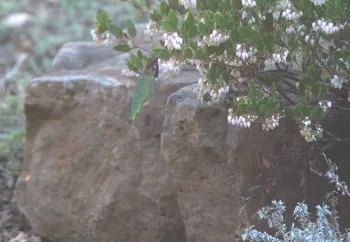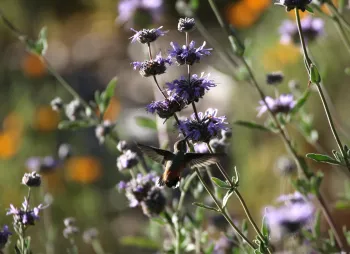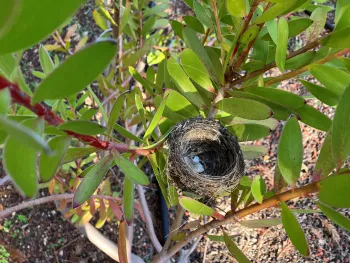
These living jewels in our gardens give us many gifts besides the joy of watching them in their pursuit of life, drinking nectar from flowers or feeders, nabbing an insect in the air, chasing another hummer from their territory, or flying acrobatics to impress the females. They bring the gift of efficient pollination by visiting hundreds of flowers daily to supply enough energy to support their metabolism. They devour insects for 80% of their diet.
Hummingbirds are mostly very small birds with long narrow beaks and fast wings that beat 60-80 times a second. They can fly forward or hover and excel at flying backward. Their tiny feet allow them to perch or scoot sideways but not to walk. This design eliminates drag in flight. Along with swifts, they belong to the order Apodiformes, meaning "footless".
Hummingbirds measure about 5 centimeters and weigh about 2-20 grams, and their speed and agility are amazing. These talents may give them the confidence needed to survive in a world so much bigger and, for some, to migrate thousands of miles. The Oholone tribe of Santa Clara Valley named Mt. Umuhnum for the word meaning "resting place of the hummingbird."
The three species of hummingbirds that live or migrate through Marin are Anna's, which are year-round residents on the West Coast; Allen's, which arrive in early winter; and Rufous, which just passes through, spending summer in Alaska and winter in Mexico.
Anna's hummingbirds are gray on the front and iridescent green on the back. Males have glittering magenta heads, while females have only a few bright patches on their throats. The colors tease, appearing black, magenta, or green depending on the angle viewed. The male Anna's hummingbird is famous for his song, but he also produces a remarkable sound with his tail feathers.

Allen's Hummingbirds have rusty red flanks with green backs. They breed along the coast from Southern California to Oregon. They are closely related to the Rufous Hummingbird and similar in appearance.
Rufous Hummingbirds fly 3,900 miles for one of the longest known hummingbird migratory flights from Alaska to Mexico. Other hummers that either fly through or reside in California are the Black-chinned, Calliope, and Costa’s hummingbirds.
Male hummingbirds court females by soaring upwards and then diving at high speed, which ends in a loud squeak produced by spreading their tail. The female is the sole nest builder and caregiver of the babies. She builds a cup-like nest woven with a spider web, plants down and lichen, and lays two eggs about the size of jellybeans. The babies are fed nectar, small insects, and spiders.
To attract these birds to our gardens, we must provide habitat, food, and water. This means growing colorful blooming nectar-producing plants available all year long. Hummers are attracted to red. Provide clean water and do not use pesticides. Feeders can be used year-round but must be kept clean and free from ants and bees.

Here are some nectar plants that hummingbirds find irresistible. Two Manzanitas, Arctostaphylos desiflora, bloom in fall and winter, and the groundcover A. Emerald Carpet blooms from winter into spring when few plants are in bloom. There are many choices for spring and summer blooming plants: Western Columbine, Aquilegia Formosa, Pitcher sage, Lepechinia fragrans, two Honeysuckle vines, Lonicera hispidula, and the orange spring bloomer L. ciliosa.
Many salvias bloom in spring and summer. Some that attract hummingbirds are Salvia clevelandii, S. spathacea, known as the hummingbird sage, and S. amistad, which blooms into fall. The plant known as Orange Bunny Ears, Cuphea Strybing Sunset, blooms almost constantly. California fuchsia, Epilobium canum, is a summer and fall bloomer.
Some succulent blooms hummingbirds appreciate are Fox Tail Agave, A. attenuate, Torch Aloe, A. camperi, Live Forever, Dudleya farinose, and Red Hot Poker, Kniphofia.
For more plants, go to UC Marin Master Gardeners Hummingbird plants. https://marinmg.ucanr.edu/plants/pollinator_habitats/
By Sara O'Keefe, May 31, 2025

